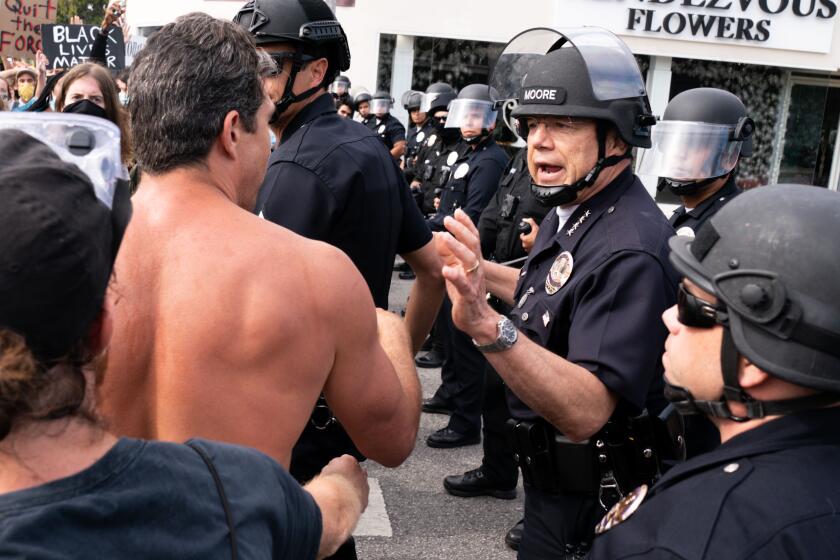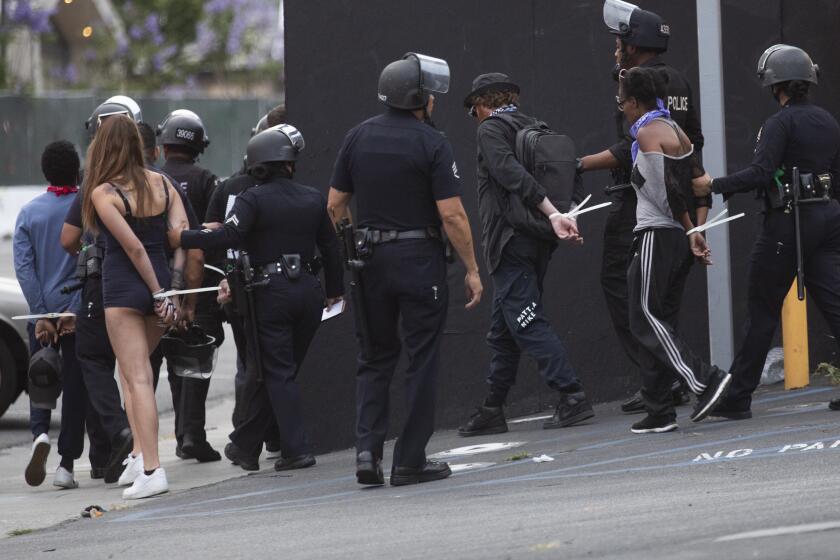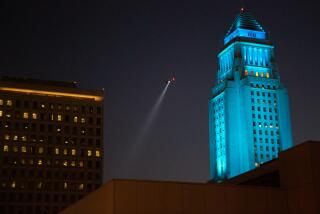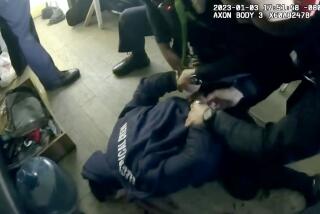Highly critical report faults LAPD for mishandling summer George Floyd unrest
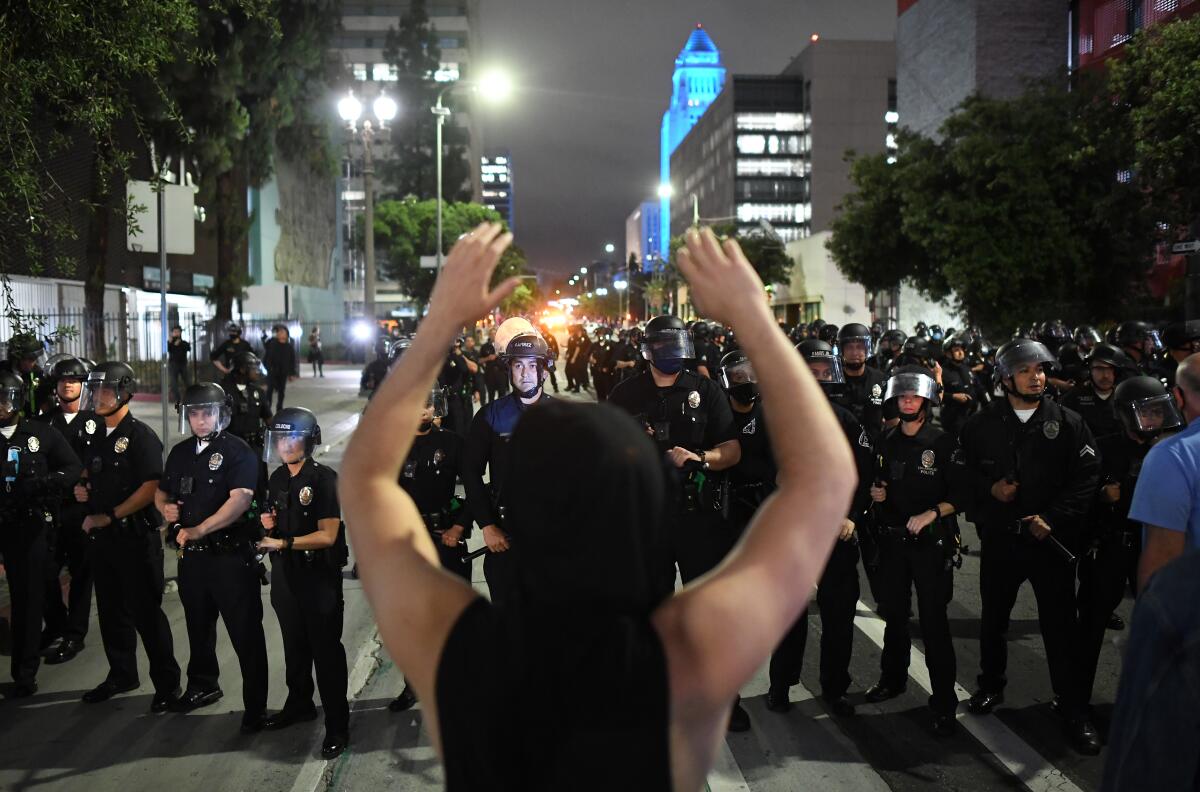
The Los Angeles Police Department mishandled the unrest that erupted on L.A. streets after the death of George Floyd, a result of poor planning, inadequate training and a disregard for rules on mass arrests and crowd control that were established after past failures to manage protests, according to a new report commissioned by the City Council.
“It is unfortunate that the same issues have arisen again and again, with the department being unable or unwilling to rectify the problem,” the report, prepared by a team of former LAPD commanders, stated.
Hundreds of people were injured or alleged their rights were violated during the summer protests. Officers were sent into the streets with hard-foam projectile weapons that they weren’t adequately trained to use, and police commanders without up-to-date training in crowd control tactics were put in charge of volatile scenes, according to the report.
Secret “shadow teams” of undercover officers were sent into crowds without sufficient means of relaying their intelligence to commanders. And high-level leaders swooped into conflicts and gave orders that contradicted those already disseminated to officers, the report found.
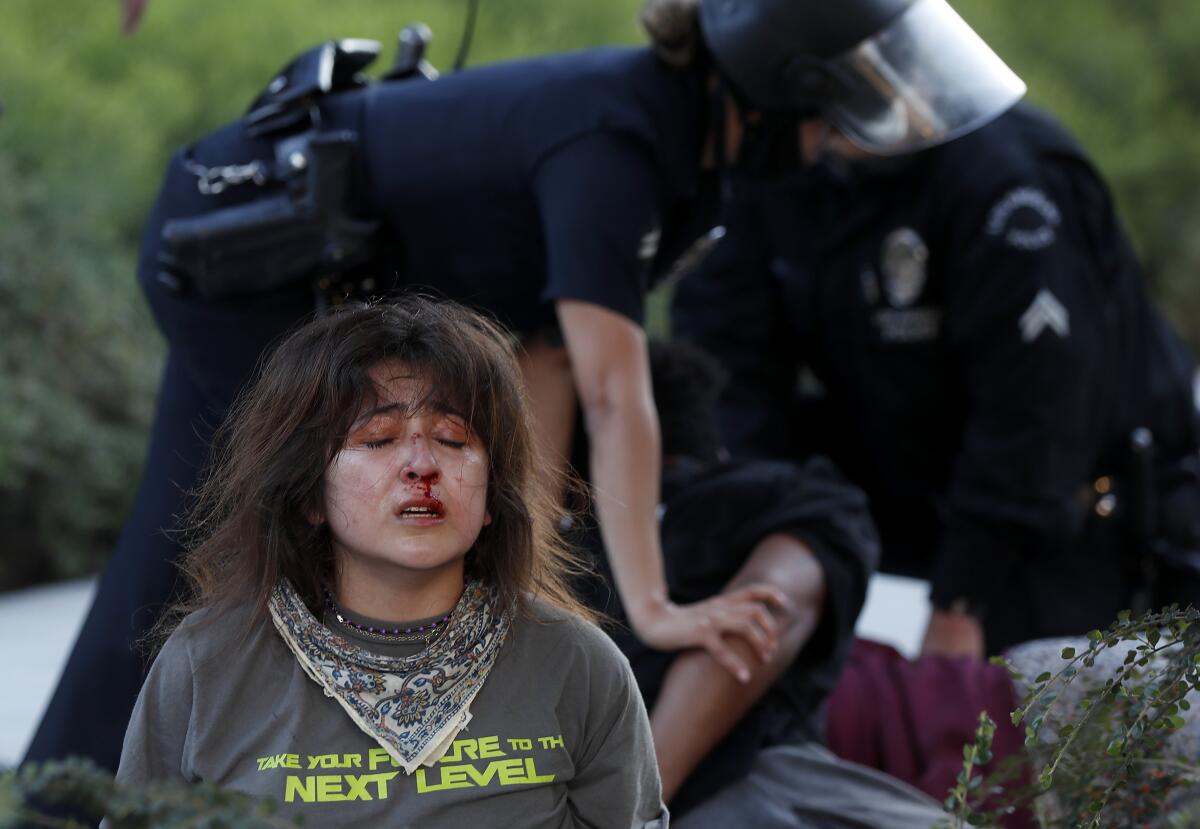
Officers formed skirmish lines and squared off with unthreatening protesters who had their hands up, even as others who were throwing objects at police from deeper in the crowds and organized groups who were running teams of burglars into surrounding businesses were left to operate freely, the report found.
Meanwhile, protesters accused of minor offenses that only warranted citations in the field were subjected to hours-long detentions, all part of a “last-minute, uncoordinated effort” by officers to arrest thousands without any clear plan for transporting or jailing those they were rounding up, the report found.
Report on LAPD’s handling of George Floyd protests describes “shadow teams,” lack of training and poor planning.
At times, even the LAPD’s own command staff didn’t know who was in charge, which “led to a chaos of command,” the review stated.
“When confronted by multiple large scale events, it is important that there be a clear chain of command, where everyone knows who is in charge, and those in charge provide clear direction,” the report said. “This did not consistently occur during the protests.”
Councilman Mike Bonin called the report “damning and disturbing.” He and another councilman who first sought the report, Marqueece Harris-Dawson, said they were especially concerned that the city had already been sued and paid out settlements over the same kinds of issues in the past.
The LAPD is being sued for violence against protesters — again. The department committed to policy changes after incidents in 2000 and 2007.
“Seeing these problems resurface almost 10 years later suggests costly stagnation or worse,” Harris-Dawson said.
Mayor Eric Garcetti said the report “makes clear we need to see better training, policies, and procedures” to ensure police can facilitate peaceful protests while maintaining safety.
The LAPD said it would not comment on specific criticisms in the report before completing its own review of the summer events, which is pending, but has already made some changes based on lessons learned — including putting thousands of officers through new crowd control training.
“It is our department’s commitment to facilitate people’s ability to express their 1st Amendment rights while ensuring that those who would prey upon others are unable to disrupt public safety, commit violence or property destruction,” the department said.
The police union said the report echoed complaints from officers about being understaffed and poorly equipped in the field, and called on officials to ensure officers are kept safe in the future.
The report is the first of three being produced on the LAPD’s handling of the late May and early June protests, which were sparked by police killings of Black people, including George Floyd in Minneapolis and Breonna Taylor in Louisville, Ky.
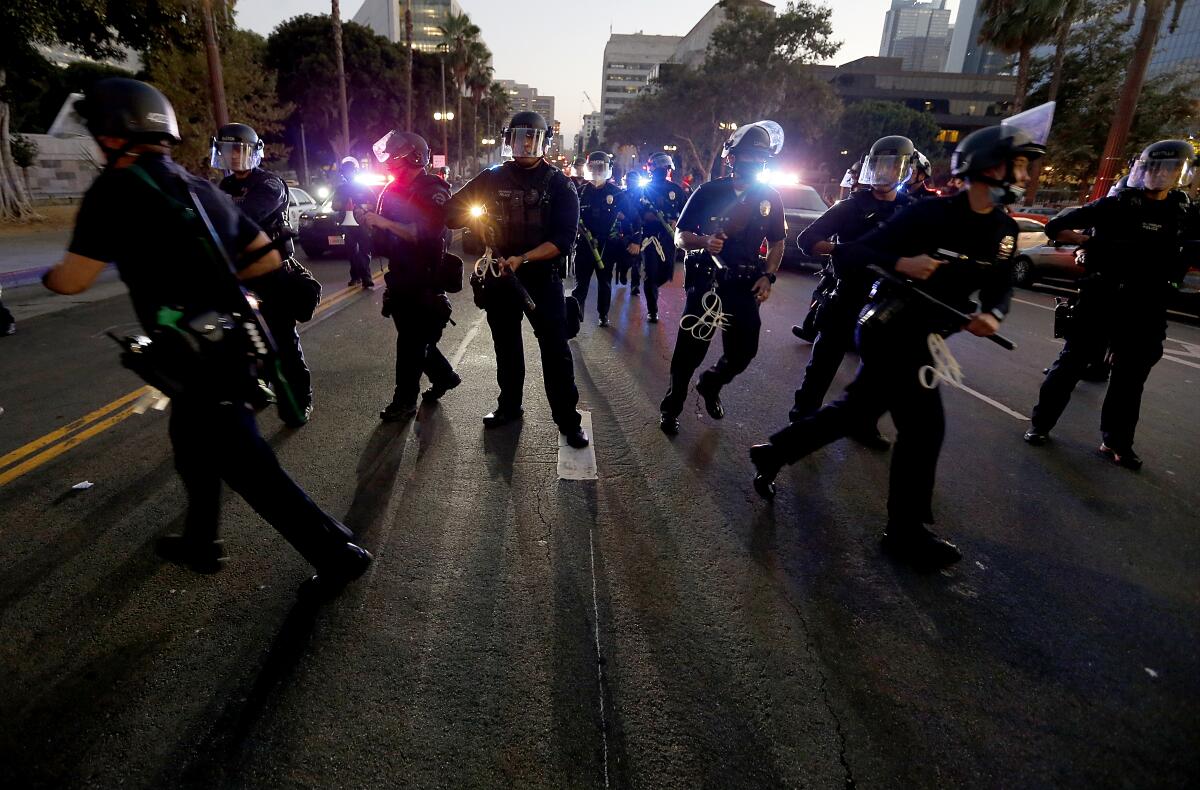
It was conducted on behalf of the City Council by a panel of former Police Department commanders led by Gerald Chaleff, an attorney and former member of the LAPD and the L.A. Police Commission who has helped review the department’s handling of past unrest.
Chaleff said in an interview that the LAPD was not prepared for the unrest and “didn’t have the training and experience that was necessary” to handle it. A better response would not have totally prevented what occurred, he said, but could have “mitigated or minimized” many problems.
LAPD used violence to quell protests over police brutality, using batons and ‘less lethal’ bullets in ways that probably violated protocols.
The LAPD is also producing its own report, and the L.A. Police Commission has contracted the National Police Foundation to conduct a third review. Both reports are pending. Garcetti said he would push for changes based on recommendations of all three reports.
In many ways, the report commissioned by the City Council outlines failings that have already been highlighted by activists and protesters, those claiming to be injured or otherwise wronged, The Times and other news media and by the LAPD itself.
In one of the largest lawsuits, brought by Black Lives Matter Los Angeles, the National Lawyers Guild and others, protesters alleged the LAPD brutalized them with projectiles and batons and violated their constitutional rights by subjecting them to hours of inhumane treatment for infractions that warranted only street citations.
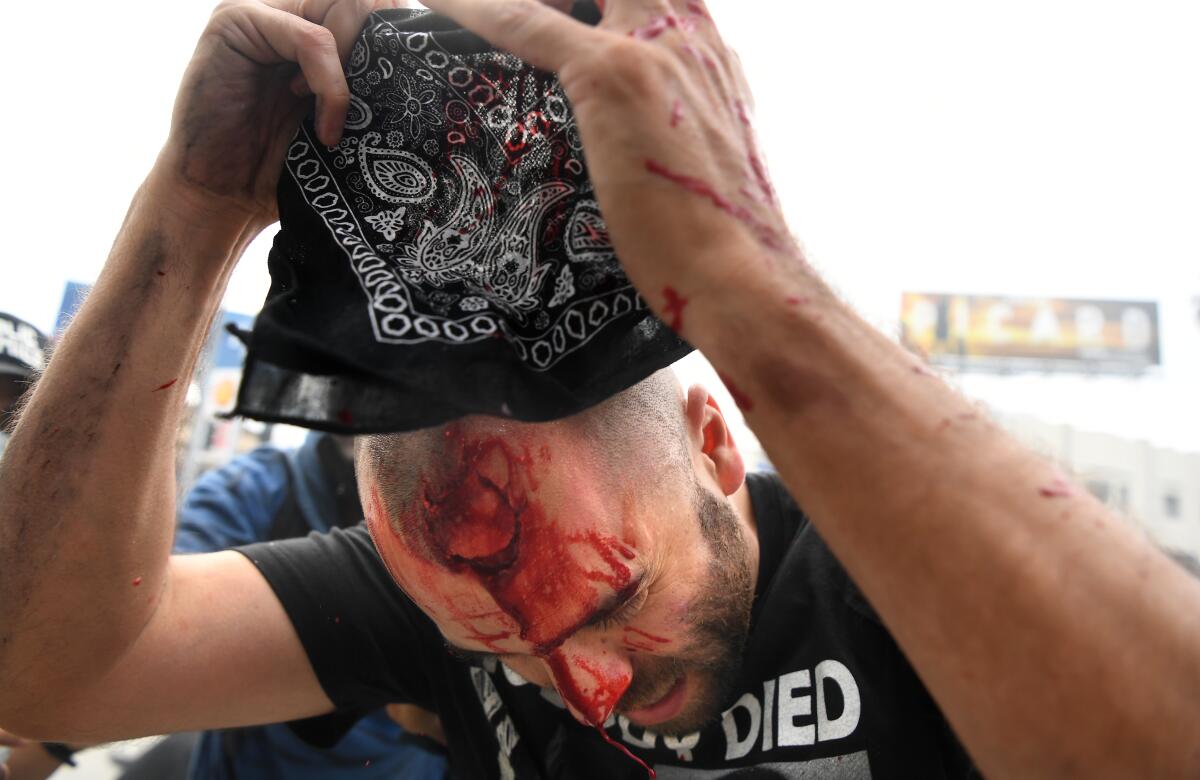
The Times has talked to multiple individuals who were badly wounded after being shot with 40-millimeter hard foam projectiles at close range despite apparently representing little or no threat to officers. One was shoved and then shot in the groin while holding a banner in a crosswalk. Another was shot in the head while standing with his arms in the air after backing away from advancing officers.
Carol Sobel, an attorney representing protesters in the BLM-L.A. lawsuit, said the new report “reinforces” their claims that officers without proper training were shooting projectiles into crowds, as well as concerns that the LAPD had failed to learn from past rebukes.
“How many times do you have to be sued on the same issues before you develop a policy?” she asked.
Melina Abdullah, cofounder of BLM-L.A., said the report addressed some of the wrongs that were perpetrated against protesters, but “what it doesn’t do is really critique the notion that LAPD should be putting down righteous protests in the first place.”
The new report does not address claims of individual harm done by officers. Its authors wrote that they were “primarily concerned with institutional issues and not individual ones,” highlighting broader failures of the department drawn from interviews with dozens of top-level commanders.
The council report faulted the department for scant training on the 40-millimeter hard foam projectile weapons, even after it expanded the number of officers allowed to use them in crowds four years ago. Many officers received only two hours of training on the weapon, which involved “firing the weapon only a few times at a stationary target” — a far different challenge than firing at a moving target within a crowd.
The LAPD used “a great deal” of such munitions during the protests, the report found: Chaleff and his team reviewed inventory records and found more than 9,700 rounds of “less lethal” munitions were never returned to the department armory, including more than 3,500 40-millimeter rounds.
Chaleff’s report also found that a slew of planning failures contributed to shoddy conditions for arrestees, another major focus of the lawsuits against the city.

People were “detained at the scene of the arrests for hours, handcuffed on the pavement, detained in buses, and taken to remote locations, without water or the use of bathroom facilities,” the report found.
Some were held for hours even though they were cited under a city code — failing to obey a lawful order — that does not allow people to be detained at length, the review found. Because the LAPD failed to quickly get buses to move people, some arrestees sat handcuffed on curbs for “exceedingly long periods of time.”
The report also found that police didn’t set up a “field jail” to handle arrestees until days into the protests, worsening the delays. When they did set one up, first at a UCLA stadium and then in the San Fernando Valley, they ended up releasing people far from where they were arrested, at late hours past a city curfew imposed in response to the unrest.
Among other concerns, the haphazard arrests resulted in health risks related to the COVID-19 pandemic, with police officers and arrestees “in close proximity, not socially distancing, many without masks,” the report found.
The report also outlined other logistical problems: The LAPD required police officers to report to Dodger Stadium before heading out to protests, forcing them to waste time driving there and back. Police were slow to set up a command post for the protests and failed to warn bureaus outside downtown to prepare for possible demonstrations. And officers battled sleep deprivation, working up to 20-hour days, because the department lacked adequate plans to relieve them, the review found.
Chaleff and his team repeatedly noted that many of the issues they identified were not new to the LAPD, but the same ones that had been called out and ordered corrected in multimillion-dollar legal settlements of the past.
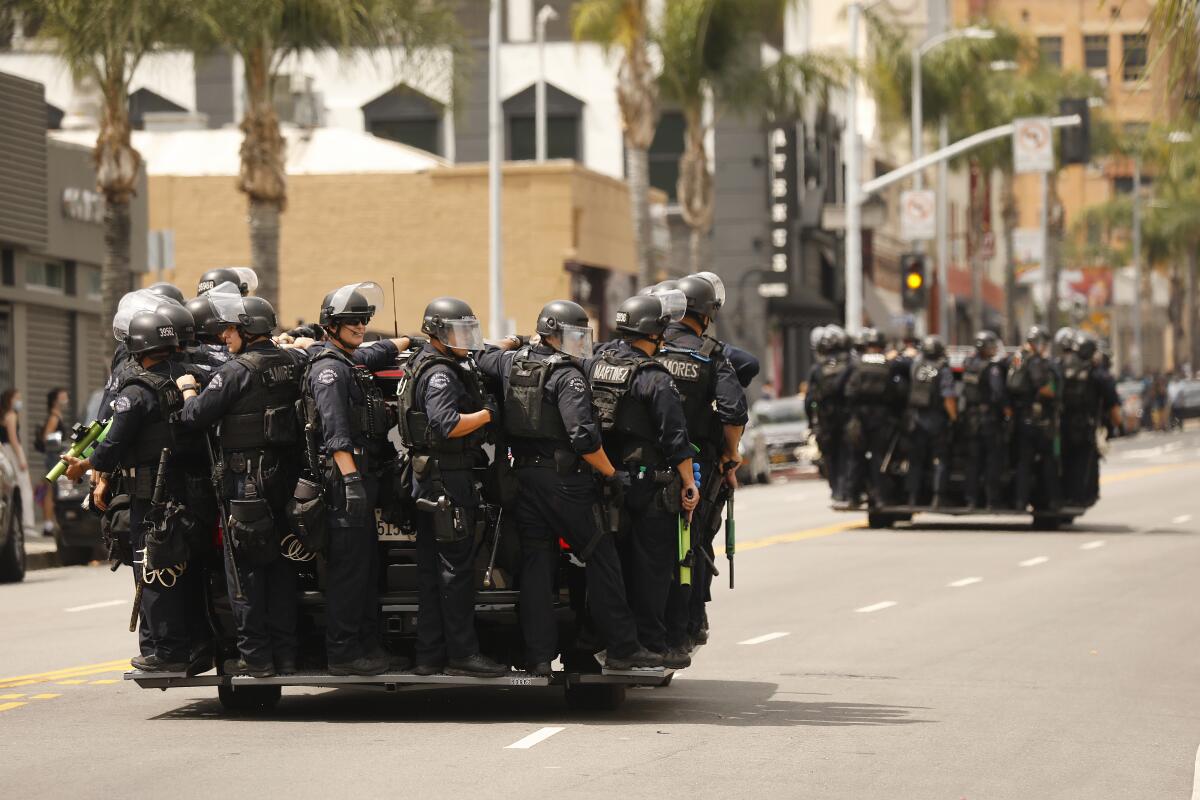
In settlements that followed LAPD clashes with protesters at the Democratic National Convention in 2000, in MacArthur Park in 2007, at the Occupy L.A. encampment in 2011 and after Michael Brown’s death in Ferguson, Mo., in 2014, the department agreed to better train officers on crowd control tactics and maintain that training, better target individual troublemakers before declaring entire gatherings unlawful, restrict the use of projectile weapons and avoid restraining arrestees for extended periods of time.
By summer 2020, however, the LAPD had abandoned some of those reforms and allowed training to lapse, including by failing to provide commanders with crowd control training for several years, the report found.
To prevent such problems in the future, the report made nearly two dozen recommendations, including hiring a new “strategic emergency manager” to ensure ongoing training and preparation for future events. Chaleff and his team also recommended regular audits to check whether the LAPD is adhering to settlements, and clamping down on which officers can use the 40-millimeter hard foam projectiles in crowds.
Abdullah and other activists were troubled by the idea of the new manager position: Hamid Khan, coordinator of the Stop LAPD Spying Coalition, argued that such an office would expand police surveillance and suppression of protests, creating “more heavy-handedness under the guise of public safety.”
Councilman Bob Blumenfield, reacting Thursday to the report, said the city must take action on the “many solid recommendations made by Mr. Chaleff” to address the “flagrant” issues seen last summer.
Others were more tentative. “We need to be thoughtful about how we process this information and how we implement changes,” said Councilman Joe Buscaino, who worked previously as an LAPD officer.
More to Read
Start your day right
Sign up for Essential California for news, features and recommendations from the L.A. Times and beyond in your inbox six days a week.
You may occasionally receive promotional content from the Los Angeles Times.
